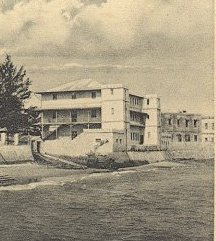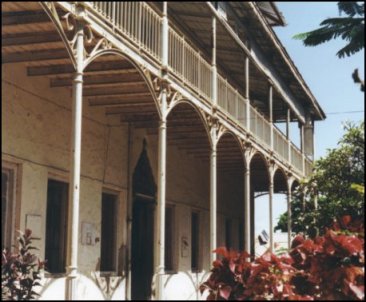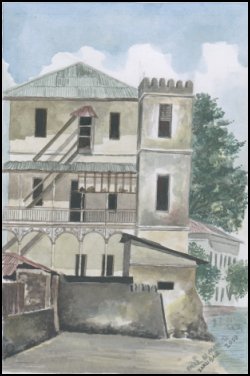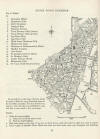Tumekuja
School
A short history of Tumekuja Secondary School (my Alma Mater)
From a report by a
previous Headmaster: 
The school has three main buildings. Two classroom buildings and a school hall.
The oldest of these buildings (address 19 A) is believed to have been in use by 1866 by the French Missionary Abbe Fava. The building was used as a convent and chapel by the "Sisters of the Precious Blood". And served as a school for Goans, Parsees, Indians and African Girls.
The adjacent building was built between 1890-1892 as a French Hospital. It was the only local "hospital for Europeans" until 1911. It later became a Netherlands Consulate, and a European residence before being incorporated into the mission school. {The school is the building shown in the adjacent 1905 photo}
The school hall was built in 1956 and the mission continued to operate it as part of the Saint Josephs Mission School until the revolution of 1964.At that time the school was taken over by the government and its name was changed to Tumekuja school.
Other interesting features of the school:
The school is located in the town area bounded by government offices. It has cellars which are believed to have been used for keeping slaves during the East African Slave Trade. The main building of the school has a very fascinating French Architecture. It is located beside the Sea Shore and throughout there is a cool breeze from the Sea
Current Status:

The School now has seven hundred and forty students. Tumekuja school teaches classes only in English. There are 4 "Forms" for regularly enrolled students. About 150 students are in each Form.The school also has another type of student, those which learn Business Skills: Commerce and Book Keeping, together with their normal subjects. There are about one hundred and forty of these students.
Number of teachers:
There are thirty-five teachers. Twenty-three are males and twelve are females. They teach students who range in age from 14 to 19 years.
Number of classrooms:
The main building has twelve classrooms. There are seventeen classes which use the classrooms in shifts of morning and afternoon. The school was closed in 1988 when its roof was devastated by strong winds. It was reopened in 1992.

Recent Events:
This year we expect to have one hundred and fifty four Form 2 graduates and seventy-six Form 4 graduates. Successful graduates who have finished Form 4 are selected to continue their advanced studies in higher schools on Zanzibar. Form 2 graduates who have passed their examination are selected to join Form 3 in this same school; others who have excelled in their results are selected to join Form 3 in the higher schools.
St Joseph's School was just one of several schools in the Stone Town section of the city. This excellent old map below shows the distribution of these schools in 1953.
Most schools were sponsored by religious or ethnic groups and many but not all were segregated by gender. The tolerant attitudes of that time allowed all these different perspectives to coexist and compete for students.
Stone Town then, as in years past, was well known for it's many teachers and scholars.
Note:
Reunions of former Students of St. Joseph's Convent School (later
Tumekuja School), Zanzibar, occur occasionally.
If you would like more information and/or would like to join a web group of
ex-students of this school please write to:
Jo Birkmeyer jbirkmeyer@yahoo.com



























































